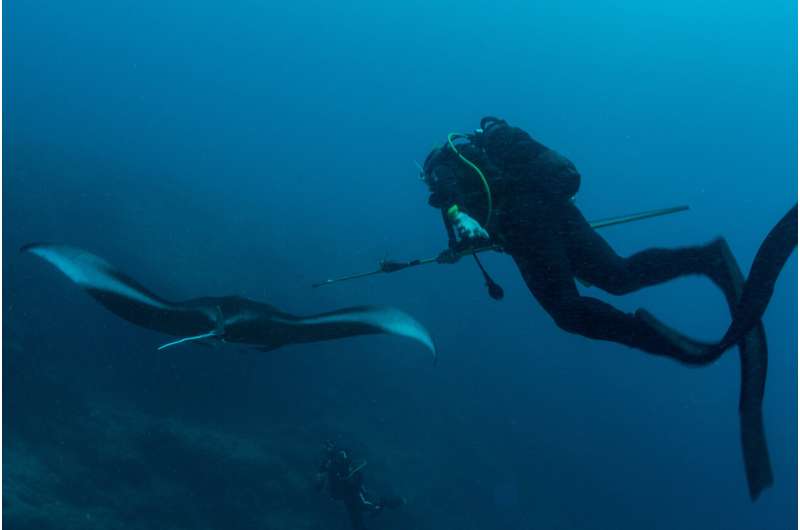Reef manta rays in New Caledonia dive up to 672 meters deep at night

The first data collected on the diving behavior of reef manta rays in New Caledonia considerably extend the known depth range for this vulnerable species in decline, according to a study published March 18 in the open-access journal PLOS ONE by Hugo Lassauce of the University of New Caledonia, and colleagues. These results add new information on the habitat use of the species in a region where manta behavior has not previously been studied, and increase their known depth range by more than 200 m.
Reef manta rays (Mobula alfredi) are declining worldwide, in large part due to fishing pressure. More detailed information on the distribution and habitat use of the reef mantas is necessary to inform conservation and fisheries management measures to ensure the long-term survival of the species, now listed as vulnerable on the International Union for Conservation of Nature Red List. Pop-up satellite archival tags (PSAT tags) are one of the most effective methods to investigate fine-scale movements and habitat use in manta rays, but until now, there have been no such studies conducted in New Caledonian waters. In the new study, Lassauce and colleagues report the results from nine PSAT tags deployed in New Caledonia, recording the world's deepest known dives for reef manta rays.
All tagged individuals performed dives exceeding 300 m in depth, with a maximum depth of 672 m. Most of the deepest dives occurred during nighttime, possibly to access important food resources. The authors hypothesize that these results may indicate zooplankton abundance in the surface waters surrounding New Caledonian coral reefs is insufficient to sustain reef manta rays. According to the authors, many of the marine protected areas throughout the known range of reef manta rays are coastal and do not extend into deeper offshore waters. As deep-water fisheries increasingly exploit this zone, the study highlights the importance of incorporating offshore waters and deep-water foraging grounds in manta conservation initiatives.
The authors add: Tagged Manta rays (Mobula alfredi) from the never-studied-before population of New Caledonia showed unprecedented deep dive behaviour. More frequent and deeper dives than ever recorded before, Manta rays of New Caledonia set a new depth range to 672 meters.
More information: Lassauce H, Chateau O, Erdmann MV, Wantiez L (2020) Diving behavior of the reef manta ray (Mobula alfredi) in New Caledonia: More frequent and deeper night-time diving to 672 meters. PLoS ONE 15(3): e0228815. doi.org/10.1371/journal.pone.0228815
Journal information: PLoS ONE
Provided by Public Library of Science



















